 Image search results - "chuo-ku" Image search results - "chuo-ku" |
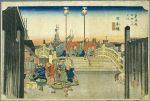
Hiroshige's woodblock print of Nihonbashi from his "Fifty-Three Stations of the Tokaido Road" series.
|
|

Eisen's woodblock print of Nihonbashi from his Kisokaido series.
|
|

Chuo-dori avenue looking toward Nihonbashi Bridge.
|
|

Nihonbashi Bridge ahead, with the expressway over it.
|
|
|
|

The original Nihonbashi Bridge was built in 1603, out of wood.
|
|

Nihonbashi Bridge and the ugly expressway above.
|
|

Nihonbashi Bridge today is the 19th reconstructed Nihonbashi Bridge since 1603. 日本橋
|
|
|
|
|
|

Bridge ornaments
|
|

Nihonbashi Bridge side view
|
|

Nihonbashi Bridge monument
|
|

The local neighborhood association wants this expressway to go underground.
|
|

The double-arched bridge was built in 1911, made of granite.
|
|
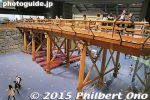
Replica of Nihonbashi Bridge at the Edo-Tokyo Museum in Ryogoku, Tokyo.
|
|
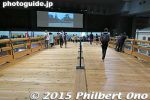
On the Nihonbashi Bridge replica at the Edo-Tokyo Museum in Ryogoku. It's not as arched as the one you see in ukiyoe prints.
|
|

About the replica of Nihonbashi Bridge at the Edo-Tokyo Museum in Ryogoku, Tokyo.
|
|

Sky roof
|
|

Expressway above the bridge.
|
|

One of the worse urban-planning decisions of the 1960s.
|
|

Nihonbashi River
|
|

Looking toward Nihonbashi on Chuo-dori
|
|

Bridge lamps
|
|

Gargoyles on bridge
|
|
|
|
|
|
|
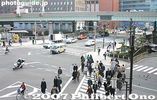
Nihonbashi as seen from Mitsukoshi Dept. Store.
|
|

Memorial square for the Zero Milestone for the Five Major Roads
|
|
|
|

Japan's Zero Milestone for Roads 日本国道路元標
|
|

Japan's Zero Milestone 日本国道路元標
|
|

Distances from the Zero Milestone to major cities such as Chiba, Mito, and Sapporo.
|
|

Distances from the Zero Milestone to major cities such as Yokohama, Kyoto, and Kagoshima.
|
|
|

Nihombashi subway station 日本橋駅
|
|

Nihombashi subway station where the Tozai and Ginza Line pass through. 日本橋駅
|
|

Way to Takashimaya Dept. Store
|
|

Chuo-dori boulevard in Nihonbashi 日本橋 中央通り
|
|

Eitai-dori 永代通り
|
|

Chuo-dori boulevard in Nihonbashi 日本橋 中央通り
|
|

Takashimaya Dept. Store in Nihonbashi 高島屋 日本橋
|
|

Takashimaya Dept. Store 高島屋
|
|

Inside Takashimaya Dept. Store, Nihonbashi
|
|

Chuo-dori toward Mitsukoshi Dept. Store
|
|

Mitsukoshi Dept. Store annex
|
|

Mitsukoshi Dept. Store in Nihonbashi 三越デパート 日本橋
|
|
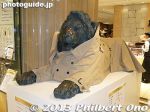
Lion statue wearing a coat inside Mitsukoshi Dept. Store in Nihonbashi in autumn.
|
|

Monument marking Tokyo's fish market during the Edo Period before it was destroyed by the 1923 earthquake and moved to Tsukiji in 1935.
|
|

Coredo complex which replaced the Tokyu Dept. Store.
|
|

Inside Coredo
|
|

Tokyu Dept. Store in Nihonbashi on Jan. 31, 1999, its last day before the store closed. This store used to be Shirokiya.
|
|
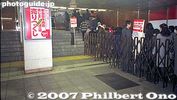
Crowd line up to enter Tokyu Dept. Store in Nihonbashi on Jan. 31, 1999.
|
|
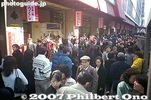
Crowd line up to enter Tokyu Dept. Store in Nihonbashi on Jan. 31, 1999.
|
|

Crowd enter Tokyu Dept. Store in Nihonbashi for the closeout sale on Jan. 31, 1999.
|
|
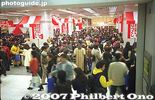
Crowd in Tokyu Dept. Store in Nihonbashi on Jan. 31, 1999.
|
|

Crowd in Tokyu Dept. Store in Nihonbashi on Jan. 31, 1999. There were bargains to be had.
|
|
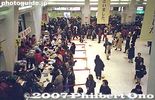
Crowd in Tokyu Dept. Store in Nihonbashi on Jan. 31, 1999.
|
|

Thank you banners in Tokyu Dept. Store in Nihonbashi on Jan. 31, 1999, last day.
|
|

Officially called the Tokyo Metropolitan Central Wholesale Market, this sprawling complex handles mainly fish, but also fruits and vegetables. This is outside the market building.Update: Tsukiji Fish Market closed on Oct. 6, 2018 since it moved to Toyosu. These pictures were taken when toursts were still free to roam around the auction area and inner market. Now a blast from the past. Sorry you missed it.
|
|
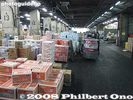
The market is near Tsukijishijō Station on the Toei Ōedo Line and Tsukiji Station on the Tokyo Metro Hibiya Line. The first subway arrives at around 5:20 am. First you walk through the fruit section..
|
|
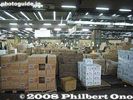
Fruit section.
|
|

Watch out for these speeding trolleys. They are almost everywhere.
|
|
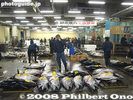
There is no map of the place so you may or may not find the tuna auctions. It's also easy to get lost in the market. This is the fresh fish tuna storage area.
|
|
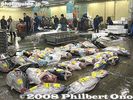
Never saw this much tuna in my life.
|
|
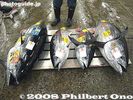
These fish can be huge, bigger and heavier than a sumo wrestler.
|
|
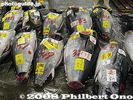
All the fish are labeled. They might indicate where the fish was caught (or raised).
|
|
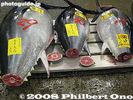
Tails are cut off to show the flesh color.
|
|
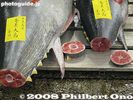
Buyers check the color of the flesh to determine how fatty the fish is.
|
|
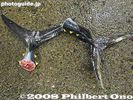
Cut-off tails
|
|
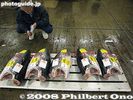
Headless tuna carcasses
|
|
|

Tuna head
|
|
|
|
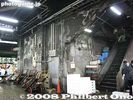
The market building has many signs of its old age.
|
|
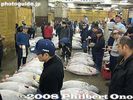
Frozen tuna auctions at Tsukiji Fish Market.
|
|
|
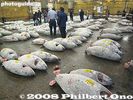
Frozen tuna anyone?
|
|
|
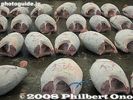
Headless frozen tuna.
|
|
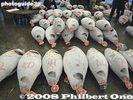
These frozen fish did not show any signs of melting. Wonder how long it takes for them to defrost.
|
|
|
|
|
|
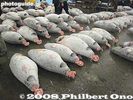
Each fish is worth thousands or tens of thousands of US dollars.
|
|

Looks good to me.
|
|
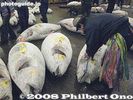
Tying a ribbon on fish.
|
|
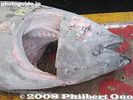
Frozen tuna head
|
|
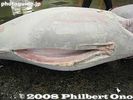
Tuna belly, the fatty part of the fish for toro sashimi.
|
|
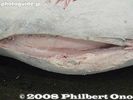
Looks yummy.
|
|
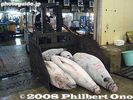
After the auctions are over, they haul out the fish using a variety methods.
|
|
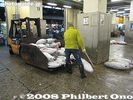
Hauling these tuna on this lift looked easy.
|
|
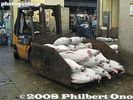
All full and ready to go. Gee, how much is all that tuna worth??
|
|
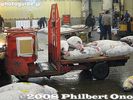
Smaller trolley for a smaller haul.
|
|
|

Hand-drawn cart.
|
|
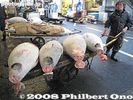
Hand-drawn cart, good for four fish.
|
|
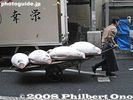
Good exercise in the morning.
|
|
|
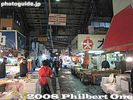
The fish is taken to the fish stalls in the market.
|
|
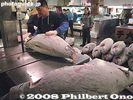
The frozen tuna is cut up into quarters lengthwise by a band saw.
|
|
|
|
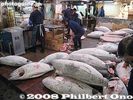
Quite a few more to cut up.
|
|
|

After the fish is cut, they shave it with an ax.
|
|

Cutting up a fresh fish. They use a long, sharp knife, and not a band saw.
|
|
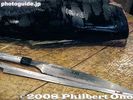
Tuna knives
|
|
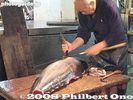
I wonder how long it takes to be able to cut up a giant tuna.
|
|
|
|
|
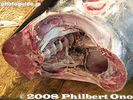
Where the head was attached.
|
|

The fresh tuna is cut up into smaller blocks.
|
|

This size is easy to sell to mom and pop sushi restaurants.
|
|
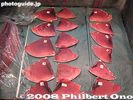
Fresh tuna
|
|
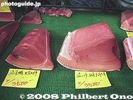
Caught in the Pacific Ocean.
|
|

The tuna flesh between the rib-like bones is also choice meat. It is scraped off with a spoon.
|
|
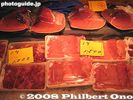
Packaged to sell.
|
|

The huge fish market consists of rows and rows of fish monger stalls, divided by narrow aisles.
|
|
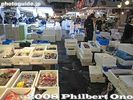
Styrofoam and plastic cartons contain all kinds of fish.
|
|
|

Fish waiting to be decapitated.
|
|
|
|
|

OK, which one's next?
|
|
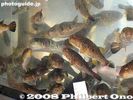
Puffer fish swim happily, ignorant of their ultimate fate.
|
|
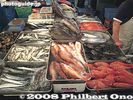
Fish and more fish...
|
|
|
|
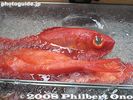
Fish in ice
|
|
|
|
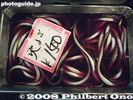
Eels
|
|

Sea urchin (uni), one of my favorites.
|
|
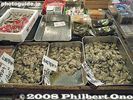
Oysters
|
|

Shellfish
|
|

Sea urchins
|
|
|
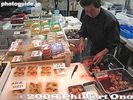
Shellfish
|
|
|
|
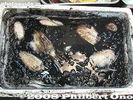
Squid in black ink
|
|

Octopi
|
|

Tako
|
|

Shrimp
|
|
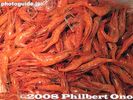
Prawns
|
|
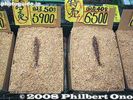
Prawns
|
|
|

Frozen crab
|
|
|

Ginza centers on the main intersection named Ginza 4-chome. This intersection is cornered by the Ginza's most famous stores like Wako and Mitsukoshi Dept. store.
|
|

This is the mother of all Ginza shopping areas in Japan. The biggest and most famous Ginza of all. Centering on the Ginza 4-chome intersection, the area is one of Tokyo's major shopping and entertainment districts.Major dept. stores, upscale shops, restaurants, galleries, and more. Ginza has been undergoing major changes in recent years with old dept. stores replaced by new buildings.
|
|

Ginza Station on the Ginza subway line is the closest station.
|
|

Ginza Station on the Ginza subway line.
|
|

Ginza Station on the Ginza subway line.
|
|

Ginza subway line. This train has a retro design based on the original subway.
|
|

Ginza subway line. This train has a retro design based on the original subway.
|
|

Modern Ginza subway line.
|
|

Ginza Station
|
|

Ginza Station exit.
|
|
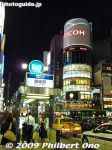
Ginza 4-chome intersection at night.
|
|

Ginza 4-chome intersection with Wako on the left and Mitsukoshi Dept. store on the right.
|
|

Ginza 4-chome intersection with Mitsukoshi Dept. store
|
|
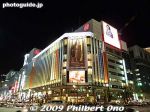
Ginza 4-chome intersection with Mitsukoshi Dept. store at night.
|
|

Ginza 4-chome intersection with Mitsukoshi Dept. store.
|
|

Ginza 4-chome intersection with Mitsukoshi Dept. store
|
|

Ginza 4-chome intersection with Wako on the left and Mitsukoshi Dept. store on the right.
|
|
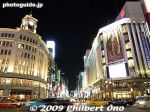
Ginza 4-chome intersection with Wako on the left and Mitsukoshi Dept. store on the right at night.
|
|

Ginza 4-chome intersection with Wako.
|
|

Ginza 4-chome intersection with Wako.
|
|
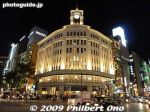
Ginza 4-chome intersection with Wako.
|
|

Ginza 4-chome intersection with Wako.
|
|

Wako Clock Tower at Ginza 4-chome intersection.
|
|
|
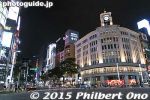
Ginza 4-chome intersection with Wako.
|
|

Cylindrical San'ai building.
|
|
|
|

Cylindrical San'ai building.
|
|
|

The new Sony building in Ginza.
|
|

The old Sony building in Ginza.
|
|

The new Sony building in Ginza.
|
|
|

Closing off the road to traffic for "pedestrian's paradise."
|
|
|
|

Closing off the road to traffic for "pedestrian's paradise."
|
|

Closing off the road to traffic for "pedestrian's paradise."
|
|

On weekends, Ginza roads are closed for pedestrians.
|
|
|
|
|
|

Ginza Mitsukoshi Dept. Store's lion statue is a popular meeting place.
|
|

Ginza Mitsukoshi Dept. Store's lion statue is a popular meeting place.
|
|

Ginza Mitsukoshi Dept. Store's lion statue is a popular meeting place.
|
|
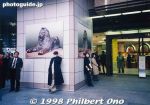
One time the lion statues was gone, so they put a large photo of it in its place.
|
|

Mother's Day photo shoot event at Mitsukoshi Dept. Store.
|
|

Mother's Day photo shoot event at Mitsukoshi Dept. Store.
|
|

Thanks mom!
|
|
|
|
|
|
|

Cats posing.
|
|

Cats posing.
|
|
|
|

Beggar
|
|

Ginza 4-chome police box koban.
|
|
|
|
|
|

Mitsukoshi annex.
|
|

Road toward Higashi Ginza.
|
|

Ginza also has many vintage camera shops.
|
|
|

Ginza used camera shop.
|
|
|
|
|
|
|
|
|
|

Yamano Music Store
|
|

Mikimoto Pearls
|
|

Mikimoto Pearls
|
|

Mikimoto Pearls
|
|
|

Ginza Matsuya Dept. Store.
|
|

Ginza Matsuya Dept. Store.
|
|

Ginza Matsuya Dept. Store.
|
|
|
|
|

Ginza Apple Store.
|
|
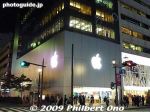
Ginza Apple Store.
|
|

Ginza Apple Store.
|
|

Ginza Apple Store.
|
|
|
|
|
|
|
|
|

Road toward where Matsuzakaya Dept. Store used to be.
|
|
|
|
|
|
|
|
|
|
|

Prada
|
|
|
|
|
|